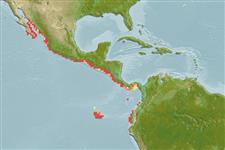Classification / Names
Common names from other countries
Main reference
Size / Weight / Age
Max length : 30.0 cm TL male/unsexed; (Ref. 55763); common length : 22.0 cm SL male/unsexed; (Ref. 9291)
Environment
Marine; pelagic-neritic; depth range ? - 70 m (Ref. 96339), usually ? - 50 m (Ref. 11035)
Climate / Range
Tropical, preferred 27°C (Ref. 107945); 28°N - 3°S, 112°W - 78°W (Ref. 54686)
Distribution
Eastern Pacific: Santa Rosalita, Pacific coast of Baja, California, Mexico southward to Punta Sal and Punta Picos, Peru. (Earlier works probably combined data for Opisthonema bulleri and Opisthonema medirastre). Range is extended northwards to San Pedro, California (Ref. 35601). Rare on outer coast of Baja California Sur (Ref. 35601).
Countries | FAO areas | Ecosystems | Occurrences | Introductions
Short description
Dorsal
spines
(total): 0;
Dorsal
soft rays
(total): 13-21;
Anal
spines: 0;
Anal
soft rays: 12 - 23. The filamentous last dorsal fin ray distinguishes it from members of any other eastern Pacific clupeoid genus. Separated from eastern Pacific Opisthonema species by having 63 to 110 lower gill rakers in fishes over 14 cm standard length.
IUCN Red List Status (Ref. 115185)
Threat to humans
Harmless
Human uses
Fisheries: highly commercial; bait: occasionally
More information
ReferencesAquacultureAquaculture profileStrainsGeneticsAllele frequenciesHeritabilityDiseasesProcessingMass conversion
Tools
Special reports
Download XML
Internet sources
Estimates of some properties based on models
Phylogenetic diversity index
PD50 = 0.5312 many relatives (e.g. carps) 0.5 - 2.0 few relatives (e.g. lungfishes)
Trophic Level
2.9 ±0.28 se; Based on food items.
Resilience
High, minimum population doubling time less than 15 months (K=0.22-0.5)
Vulnerability
Low vulnerability (25 of 100)
Price category
